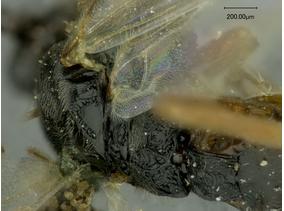You are here
Extant genera and species of Microgastrinae
Apanteles balthazari (Ashmead 1900)
Nomenclature
-
Subfamily: MicrogastrinaeGenus: Apanteles
SUMMARY
Type locality. ST. VINCENT, Lesser Antilles.
Holotype. ♀, BMNH (examined).
Description. Female. Body color: body mostly dark except for some sternites
which may be pale. Antenna color: scape, pedicel, and flagellum dark. Coxae color
(pro-, meso-, metacoxa): dark, dark, dark. Femora color (pro-, meso-, metafemur):
pale, pale, pale. Tibiae color (pro-, meso-, metatibia): pale, pale, pale. Tegula and
humeral complex color: tegula pale, humeral complex half pale/half dark. Pterostigma
color: mostly pale and/or transparent, with thin dark borders. Fore wing veins color:
mostly white or entirely transparent. Antenna length/body length: antenna about as
long as body (head to apex of metasoma); if slightly shorter, at least extending beyond
anterior 0.7 metasoma length. Body in lateral view: not distinctly flattened dorso– ventrally. Body length (head to apex of metasoma): 2.9–3.0 mm. Fore wing length:
3.1–3.2 mm. Ocular–ocellar line/posterior ocellus diameter: 1.7–1.9. Interocellar distance/
posterior ocellus diameter: 1.7–1.9. Antennal flagellomerus 2 length/width: 3.2
or more. Antennal flagellomerus 14 length/width: 1.7–1.9. Length of flagellomerus 2/
length of flagellomerus 14: 1.7–1.9. Tarsal claws: simple. Metafemur length/width:
2.8–2.9. Metatibia inner spur length/metabasitarsus length: 0.4–0.5. Anteromesoscutum:
mostly with deep, dense punctures (separated by less than 2.0 × its maximum
diameter). Mesoscutellar disc: mostly smooth. Number of pits in scutoscutellar sulcus:
7 or 8. Maximum height of mesoscutellum lunules/maximum height of lateral face of
mesoscutellum: 0.6–0.7. Propodeum areola: completely defined by carinae, including
transverse carina extending to spiracle. Propodeum background sculpture: mostly
sculptured. Mediotergite 1 length/width at posterior margin: 1.1–1.3. Mediotergite 1
shape: more or less parallel–sided. Mediotergite 1 sculpture: mostly sculptured, excavated
area centrally with transverse striation inside and/or a polished knob centrally on
posterior margin of mediotergite. Mediotergite 2 width at posterior margin/length:
2.8–3.1. Mediotergite 2 sculpture: more or less fully sculptured, with longitudinal
striation. Outer margin of hypopygium: with a wide, medially folded, transparent,
semi–desclerotized area; usually with 4 or more pleats. Ovipositor thickness: about
same width throughout its length. Ovipositor sheaths length/metatibial length: 1.4–
1.5. Length of fore wing veins r/2RS: 1.1–1.3. Length of fore wing veins 2RS/2M: 2.1
or more. Length of fore wing veins 2M/(RS+M)b: 0.5–0.6. Pterostigma length/width:
3.1–3.5. Point of insertion of vein r in pterostigma: clearly beyond half way point
length of pterostigma. Angle of vein r with fore wing anterior margin: clearly inwards,
inclined towards fore wing base. Shape of junction of veins r and 2RS in fore wing:
strongly angulated, sometimes with a knob.
Molecular data. No molecular data available for this species.
Biology/ecology. Hosts: Gelechiidae, Pectinophora gossypiella.
Distribution. Brazil, Cuba, Grenada, St. Vincent. There is no suggestion that this
species occurs in ACG.
Comments. The original description from Ashmead (1900) does not match the
holotype. His description of the T1 shape, T2 sculpture, and coloration of meso and
metafemora are completely different from the actual specimen.






